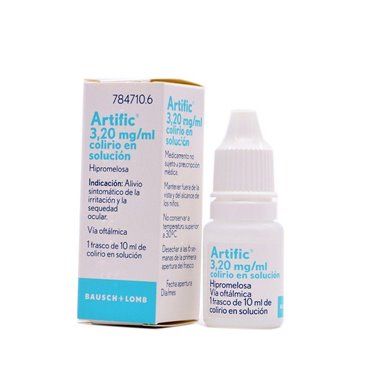Artific 3.20 mg/ml Eye Drops in Solution 10Ml
Artific is a medicine that belongs to the group of artificial tears and is indicated for the symptomatic relief of irritation and dry eyes.
Artific is a medicine that belongs to the group of artificial tears and is indicated for the symptomatic relief of irritation and dry eyes.
Artific (3.2 Mg/Ml Eye Drops In Solution 1 Bottle 10 Ml)
ACTION AND MECHANISM
- Eye lubricant. Hypromellose is a methylated and hydroxylated cellulose derivative, with high viscosity, which exerts a lubricating effect by increasing the residence time of the tear on the ocular mucosa.
PHARMACOKINETICS
- Absorption: due to its high molecular weight, its corneal absorption is not expected.
INDICATIONS
- Relief of [DRY EYE] when the eye is subjected to irritating agents that cause dry eyes and discomfort.
POSOLOGY
- Adults: 1 drop in each affected eye, 3-5 times a day, or on demand depending on the severity of the symptoms.
- Children and adolescents <18 years: safety and efficacy have not been evaluated.
- Elderly: does not require dose readjustment.
Forgotten dose : administer the next dose at the usual time. Do not double the next dose.
DOSAGE IN RENAL FAILURE
No specific dosage recommendations have been made.
DOSAGE IN LIVER FAILURE
No specific dosage recommendations have been made.
RULES FOR CORRECT ADMINISTRATION
Extreme precautions must be taken to avoid contaminating the eye drops during the entire administration of the medication. To do this, hands should be washed before administration and the dropper should not come into contact with any surface of the body, including the eyelids and surrounding areas.
"Standards for eye drops administration"
1. Tilt your head back.
2. Pull the lower eyelid with an index finger and look up.
3. Instill one drop into the conjunctival sac, keeping the bottle upright with the dropper pointing downwards.
4. Once the drop has been applied, blink repeatedly to distribute the eye drops. To reduce possible systemic absorption, it is recommended to press the lacrimal sac for one minute or close the eyelids tightly for 2-3 min, immediately after administration of the eye drops.
If other ophthalmic drugs are being used, it is recommended to separate the administrations by at least 5 min. It is recommended to administer hypromellose last, since due to its viscosity it could alter the absorption of other ophthalmic active ingredients.
CONTRAINDICATIONS
- Hypersensitivity to hypromellose or any other component of the medication.
ADVICE TO THE PATIENT
- Consult your doctor and/or pharmacist if the symptoms worsen or do not improve in the following 72 hours, or if you experience pain, eye irritation or visual disturbances.
- Soft contact lens wearers should remove them before administering this eye drop and wait at least 15 minutes before putting them back on.
INTERACTIONS
No interaction studies have been performed.
PREGNANCY
Safety in animals : no data available.
Safety in humans : Adequate and well-controlled studies in humans are not available. Its administration is only accepted if there are no safer therapeutic alternatives, and the benefits outweigh the possible risks. Hypromellose does not appear to present significant absorption.
Effects on fertility : No specific studies in humans have been performed.
LACTATION
Safety in animals : no data available.
Safety in humans : it is not known if it is excreted in milk, and the consequences that it could have for the nursing infant. Hypromellose does not appear to present significant absorption.
CHILDREN
The safety and efficacy in children and adolescents under 18 years of age have not been evaluated, so no dosage recommendations can be made.
SENIORS
No specific problems have been described in the elderly that require a dose readjustment.
EFFECTS ON DRIVING
Hypromellose does not appear to significantly affect driving ability. However, like any other ophthalmic drug, blurred vision may appear immediately after use. It is recommended to avoid driving until vision is normal.
ADVERSE REACTIONS
Adverse reactions are described according to each frequency interval, being considered very common (>10%), common (1-10%), uncommon (0.1-1%), rare (0.01-0.1%). , very rare (<0.01%) or frequency unknown (cannot be estimated from the available data).
- Ophthalmological: infrequent [BLURRY VISION], [EYE IRRITATION] or adhesiveness of the eyelids.
ADVERSE REACTIONS RELATING TO EXCIPIENTS
- Very rare cases of [CORNEAL CALCIFICATION] associated with the use of eye drops containing phosphates have been reported in some patients with significant corneal involvement.
OVERDOSE
Symptoms : there is no clinical experience. The risk of overdose does not seem significant due to its route of administration and low absorption.
Treatment : not required.



